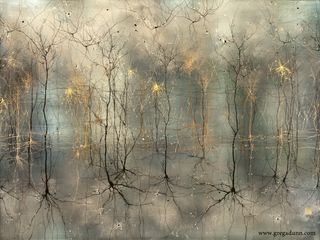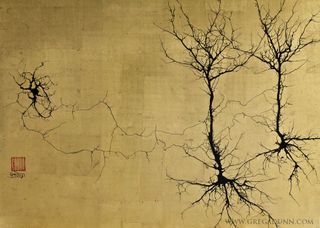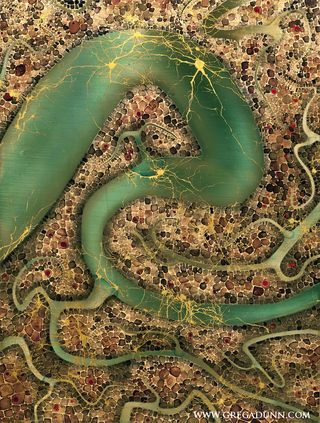Dazzling Images of the Brain Created by Neuroscientist-Artist
The brain has been called the most complex structure in the universe, but it may also be the most beautiful. One artist's work captures both the aesthetics and sophistication of this most enigmatic organ.
Greg Dunn earned a PhD in neuroscience before deciding to become a professional artist. "I had been a scientist in my previous life," Dunn said.
The patterns of branching neurons he saw through the microscope reminded him of the aesthetic principles in Asian art, which he had always admired. Dunn realized that neurons could be painted in the sumi-e (ink wash painting) style, which involves making as few brush strokes as possible to capture the soul of the subject. [Research as Art: A Gallery of Scientific Beauty]
"The microscopic world belongs in the world of Asian art," Dunn said. "There's no distinction between painting a landscape of a forest and a landscape of the brain." Here are a few of his dazzling creations.
Cortical Columns (21K, 18K and 12K gold, ink, dye, and mica on aluminized panel)

Dunn's early work involved very minimalist compositions. He uses microscope images to inspire him, but he paints all the neurons himself.
"It's almost a zen quality to the branching pattern of a neuron that I was interested in capturing initially," he said. (Credit: Greg Dunn)
Sign up for the Live Science daily newsletter now
Get the world’s most fascinating discoveries delivered straight to your inbox.
Basket and Pyramidals (Ink on 22K gold)

Dunn developed a process that involves blowing ink around on non-absorbent paper. The shape of the paper and the turbulence in the air cause the ink to splatter in a way that perfectly captures the treelike tangles of a neuron. (Credit: Greg Dunn)
Gold Cortex II (Ink on 22K gold)

There's a degree of randomness in the branching patterns of neurons that is difficult to capture when painting them."If you try to paint neurons by hand, you adhere to all kinds of unconscious rules," Dunn said.
By contrast, the ink blowing technique is kind of like Italian cooking, he said — you just get the best ingredients, and learn to control them. (Credit: Greg Dunn)
Cortical Circuitboard (Microetched gold on steel)

Dunn's newer work involves using a technique called microetching. He creates these etchings in collaboration with his colleague Brian Edwards.
First, Dunn paints all the neurons by hand. Next he scans them into a computer and assembles them into an image using photo-editing software. Then, Dunn and Edwards create a high-resolution image out of hatched lines; the angles of these lines determine how light will reflect off the image. (Credit: Greg Dunn and Brian Edwards)
Electron micrograph of microetching

Next, Dunn and Edwards etch the image onto metal using a technique called photolithography, which is how microchips are made.
First they print the image onto a transparent sheet, which is placed over light-sensitive material laminated to a sheet of steel. Everywhere the transparency has black ink, it prevents the light from hitting the light-sensitive layer. Next, they shine ultraviolet light on the metal, which engraves the image everywhere the photosensitive layer was blocked by the ink. Finally, they apply gold leaf to the surface. (Credit: Greg Dunn and Brian Edwards)
Brainbow Hippocampus in Blues (Microetched gold on steel)

Dunn and Edwards build lights and shadowboxes around the frames of the engravings, to add different colors. By controlling the angle that the light hits the image, they can control the color of that part of the image.
The image above was inspired by the Brainbow process, a neuroscience technique for coloring neighboring neurons by combining colored fluorescent proteins. (Credit: Greg Dunn and Brian Edwards)
Brainbow Hippocampus variations

Here, the Brainbow Hippocampus is shown under different lighting conditions. "You can get an infinite number of appearances, because there's no color in the surface [of the image]," Dunn said. (Credit: Greg Dunn and Brian Edwards)
Glia and Blood Vessels (22K and 12K gold, dye on stainless steel)

While much of Dunn's work focuses on neurons, his subjects also include other tissue types, such as glia, non-neuronal brain cells that provide support and protection for neurons. These cells are increasingly thought to play an important role in the brain. (Credit: Greg Dunn)
Glial Flare (22K and 21K gold, and dye on aluminized panel)

Another image of glia. (Credit: Greg Dunn)
Spinal Cord (12K gold, ink, and dye on stainless steel)

One of Dunn's most arresting pieces isn't of the brain at all, but of a slice of the spinal cord.
Through his art, Dunn hopes to give voice to scientists whose work usually isn't appreciated by the general public, he said. "Art has the power to capture people's emotions and inspire awe [in a way] that a lot of charts and graphs don’t have." (Credit: Greg Dunn)
More information about Dunn's artwork and pieces for sale is available on his website.
Editor's Note: If you have any science-themed art you'd like to share for a possible story or image gallery, please contact managing editor Jeanna Bryner at LSphotos@livescience.com.
Follow Tanya Lewis on Twitter. Follow us @livescience, Facebook & Google+.
